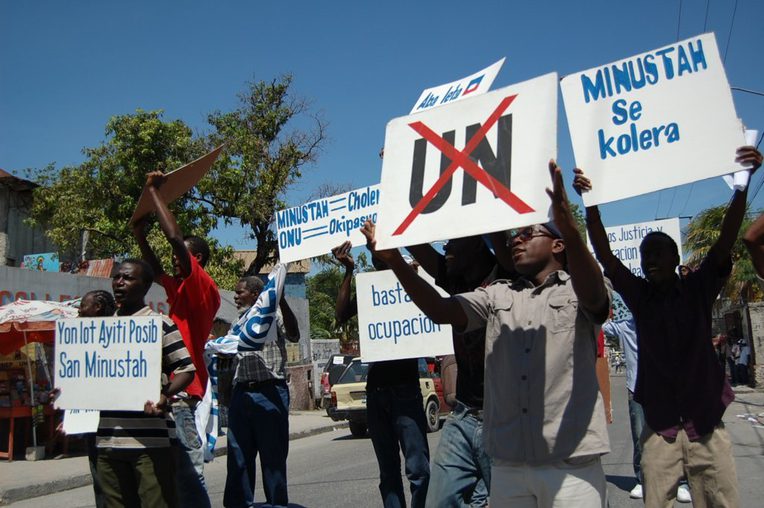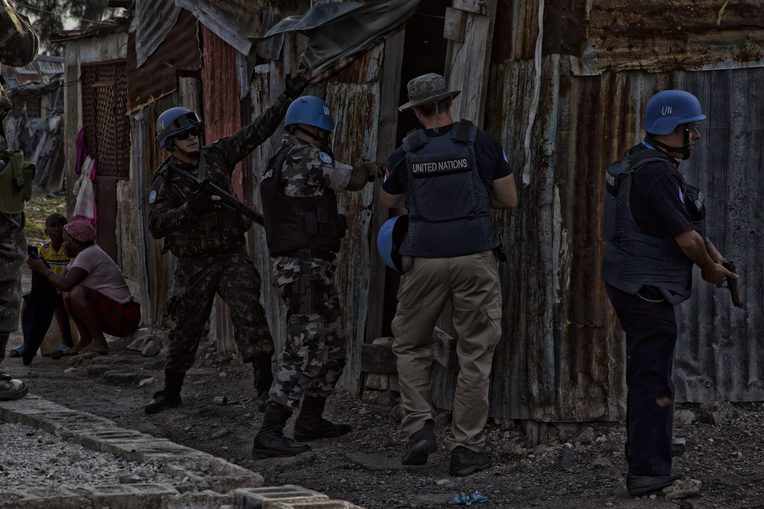Cholera, Colonization, and the UN’s Militarized Humanitarianism in Haiti
From the Series: Ecologies of War
From the Series: Ecologies of War


In early October 2010, I learned through social media that people in rural Haiti were getting sick and dying from what appeared to be cholera. It was unusual, the sources explained, since cholera has not been in Haiti for over a century. I contacted a friend in Port-au-Prince who was tapped into local Haitian politics and asked him if the rumors of cholera were true. “Yes,” he replied immediately. “It’s from some of the MINUSTAH troops. And the UN knows it. They already shipped out the soldiers responsible.”
MINUSTAH is the French acronym for the United Nations Stabilization Mission in Haiti, the official “peacekeeping” mission that began on June 1, 2004, three months after a Western-backed coup d’état. US Special Forces removed Haiti’s elected president, Jean Bertrand Aristide, from office and flew him to the Central African Republic (Pierre 2020). Quickly approved by the UN Security Council, the UN mission was ostensibly sent to “stabilize” the country in the context of impending “chaos” due to a power vacuum.
By all accounts Haiti was under control—figuratively and literally. But the Chapter VII peacekeeping mission was an extraordinary move by UN leaders, considering that Haiti was not at war (Ciechanski 2007). From the beginning, Haitian people had denounced the abuses by the occupation troops. The peacekeeping mission would become known for its brutal repression, rampant corruption, and sexual exploitation.
The peacekeeping mission also transformed the local landscape. The infrastructure needed to sustain such a large-scale, multibillion-dollar operation—thousands of military troops, civilian personnel, and volunteer groups—included semipermanent and permanent structures throughout Haiti. Indeed, in addition to the large structure housing the mission in Port-au-Prince, there were MINUSTAH encampments—bases, camps, outposts—scattered throughout the country. No matter how small, the encampments were prominent, painted in bold blue and guarded by well-armed soldiers. Moreover, local populations had to deal with the tanks and trucks filled with soldiers with large machine guns pointing at them. In my mother’s tiny hometown of Maïssade, which lacks paved roads, large armed MINUSTAH truck and tank patrols were a common sight.

The environmental and ecological impacts of large-scale military occupations are significant. A recent study reveals that “a mission of 15,000 peacekeepers produces about 11,000 tons of solid waste a year” (Maertens and Shoshan 2018, 6). This does not include waste from spent ammunitions, emissions, and from the transformation of lands. Haiti, always castigated for alleged self-inflicted environmental degradation, also had to absorb thousands of tons of UN-generated waste. With thousands of foreign troops and civilian forces fanned out across the country at any given time, it suffered through both the brutality of a foreign occupation and the ecological ruination inherent to such occupation. The cholera epidemic is an extension of a totality of violence—material, political, and ecological—enacted by the UN peacekeeping mission.
Early speculation, in the West, about cholera’s origins deployed well-worn stereotypical and racist tropes of Haiti’s poverty and unsanitary conditions. However, affected local communities had already pinpointed the source: the UN Méyè base located a few meters from a stream flowing into the Artibonite River, the main water source for the surrounding villages. Local communities complained of large septic trucks regularly dumping fecal waste into the river. Jonathan Katz, an AP reporter based in Haiti at the time, went to the UN base where villagers led him to the site at the back of the base, which was barely separated from the river. He reports: “The stench of rotting human filth was debilitating. We held our breath and crossed a concrete embankment along the ridge. . . . Down the ridge, exposed, lay a broken PVC pipe. Running from near what looked like a building of latrines inside the perimeter, it leaked a black liquid toward the river” (2013, 228). A farmer near the UN base later led Katz to a nearby field close to his house where there were two uncovered pools of feces. “This is where MINUSTAH leaves their kaka,” the farmer said (228).
How does one not read this desecration of the Haitian villager’s land and water as also a blatant disregard for them as human beings, and as an extension of war and occupation? Can we even imagine a UN outfit conducting itself this way in a European village? In a White US or Canadian neighborhood?
Cholera is a putrid, filthy disease. It takes away one’s dignity. People who are infected quickly develop severe diarrhea, vomiting, a rapid loss of body fluids that leads to dehydration and a severe shock to the body. And cholera can kill within hours. For those in the villages first affected, cholera was a death sentence. A lack of infrastructure and a dearth of hospitals and clinics meant that many were doomed to immediate death. Those that were lucky to make it to clinics and hospitals had to endure the public humiliation of the disease. It is significant to point to the public indignity suffered by those affected; Haiti’s Black citizens are the constant subjects of debased journalistic and ethnographic portrayals.
It took three years to bring cholera under nominal control. In that time, it is estimated that between 10,000 and 30,000 people had died from the terrible symptoms of the disease. The number of victims is likely higher.
For six years, the UN denied responsibility for bringing cholera to Haiti. They also responded to Haitian requests for accountability and reparations with cruel impunity: when the Institute for Justice and Democracy in Haiti sued the UN for redress, Secretary General Ban-Ki Moon asserted that the charges against the organization were “not receivable”—that is, the UN would not accept the charges. UN reversed course in 2016, admitting its culpability and issuing an apology. But no restitution was offered. And the thousands of Haitians who died, and the millions of Haitians whose lives had been upended, became the forgotten causalities of the ecological catastrophe of a pointless military occupation.
Ciechanski, Jerzy. 2007. “Enforcement Measures under Chapter VII of the UN Charter: UN Practice after the Cold War.” International Peacekeeping 3(4): 82–104.
Katz, Jonathan M. 2013. The Big Truck That Went By: How the World Came to Save Haiti and Left Behind a Disaster. New York: St. Martin’s.
Maertens, Lucile, and Malkit Shoshan. 2018. Greening Peacekeeping: The Environmental Impact of UN Peace Operations. New York: International Peace Institute.
Pierre, Jemima. 2020. “Haiti: An Archive of Occupation, 2004–.” Transforming Anthropology 28(1): 3–23.